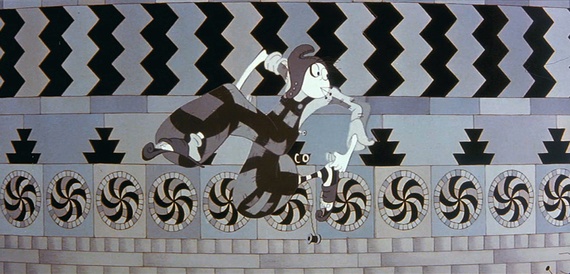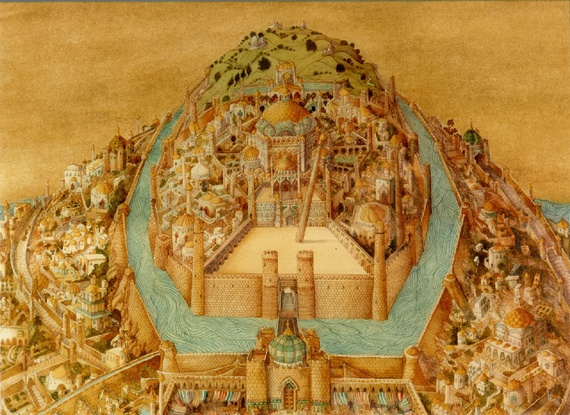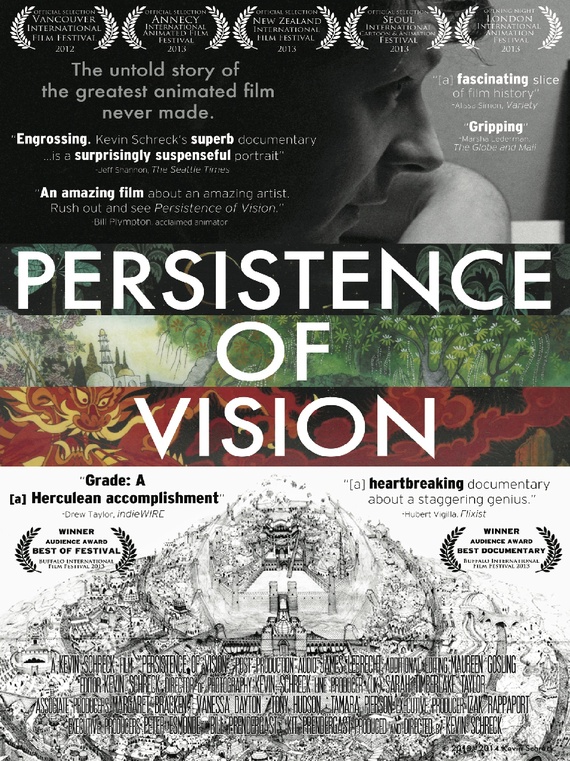----
The Greatest Animated Film That Never Was
// The Atlantic Wire

If you've ever seen Who Framed Roger Rabbit, 1971's A Christmas Carol, or the titles for The Pink Panther, you've seen the work of Richard Williams. Now in his 80s, the animator, director, and designer has created thousands of animated film titles and commercials and even written a book on the art of animation. All this despite the fact that for three decades he was sacrificing other work to direct one immense film that never made it to screen, the Fantasia-esque Arabian tale called The Thief and the Cobbler.
Williams refuses to speak about the film now, which his studio reneged on and sold to another company that recut and released it in an adulterated form. But the director's reticence to speak didn't stop documentary filmmaker Kevin Schreck from telling the story of the film's failure. Released in 2012 and recently made available on a limited-edition DVD, Persistence of Vision is an illuminating exploration of William's relentless quest for innovation and perfection during the years he toiled over his passion project.
"I became obsessed with this story of obsession," Schreck told me. As a young, aspiring animator himself, Schreck had heard William's lost film was supposed to be a masterpiece and was blown away by the detail, scale, and craftsmanship in the bits of the director's original footage he was able to see. Yet when he heard stories about the making of the incomplete epic, the film itself paled in comparison. "I found that story even more exhilarating, fascinating, and tragic than the movie itself," he told me.
PERSISTENCE OF VISION - Trailer from Kevin Schreck on Vimeo.
Shreck would embrace his impulses and start planning a documentary based on the troubled production. But how could the story be told without its own protagonist? Knowing that Williams would never agree to participate, Schreck compiled archival materials and the independent accounts and anecdotes of animators and artists who worked at Williams's studio over the course of the massive project. The collage of viewpoints and varied chronologies (some of the later artists were infants at the time the production actually began) is threaded through by the accounts of those who were there for the whole thing.
There was also the issue of original footage, but Schreck soon learned clips from the The Thief and the Cobbler had been hoarded by collectors. One such collector was Garrett Gilchrist, who pieced together the fan restoration The Thief and the Cobbler: The Recobbled Cut (watch here) in 2006. More came from people who originally worked on the film. One animator even uncovered some analog U-matic tapes and converted them to digital for Schreck to use. "It turned out to be roughly two hours of animation that nobody had seen in over two decades, some footage dating back to the 1960s," Schreck said. All together the fan collections were the components that "made telling this story as a documentary possible."


For all the cult interest in The Thief and the Cobbler now, Schreck's film doesn't shy away from showing the mistakes Williams made along the way. Like the fact that the film's protagonist bore a striking resemblance to Jafar from Walt Disney's Aladdin (1992), which was scheduled to be released around the same time. To Schreck, the intention in the likeness—which posed a liability for Williams's studio, Warner Bros—is ambiguous: "It's hard to say how much was deliberate theft, accidental inspiration, or mere coincidence," Schreck says, allowing that it might be a combination of the three. All the same, a bad situation: "Whatever it is, it wasn't good for Williams."
It especially wasn't good for Williams's testy relationship with Warner Bros., and would be one of the reasons why the studio contractually pulled The Thief and the Cobbler from his control. (Others included the fact he couldn't make their preordained deadline, and they didn't like an initial rough cut.) Warner Bros. installed the film at Miramax Family Films, which ultimately butchered Schreck's vision—making it more Disneyesque, with a slick musical soundtrack—under the new title Arabian Knight (1995).
Where others might have pointed fingers, Schreck explores Williams's motivations for making his great fiasco. Williams himself has said that the movie was a mammoth ego trip—shown in one of the film's historical interview clips—but Schreck isn't so certain. "I do think there's a bit of [ego] in there," he says. "But I think a lot of it was a love of the art of animation and being a perfectionist in the truest sense of the term, too. Maybe it's hard to separate the two in some contexts."
Williams has been a big influence on Schreck as an animator, but Schreck is careful to say he did not want to make "a fawning, myopic, fanboy wank of a movie." As he was making the film and learning more about what unfolded, Schreck began to see it wasn't a rote story of an artist versus Hollywood. "It's not that simplistic," Schreck said.

Instead, Persistence of Vision celebrates what could have been. It offers a generous assortment of clips from the cutting room, most surprisingly Williams's intricate, lengthy tour de force battle sequence in which a satanically-inspired war machine's massive gears and wheels appear to crush all humanity in its path. The sequence represents an amazing work of manual craftsmanship by Williams, his right-hand man Roy Naisbitt, and their small army of artists working on the scene. "It's mind-boggling to think that it was created by human hands, with no computers involved at all," Schreck says.
Schreck did, at one point, reach out to Williams for comment, but no luck. No word yet about his thoughts on the film, either. "I don't feel compelled to pressure him to talk," Schreck said, "The ball is in his court, as far as I'm concerned."

----
Shared via my feedly reader
Sent from my iPhone
No comments:
Post a Comment